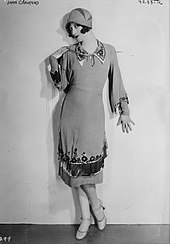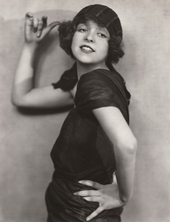Flapper
In the 1920s, the term flapper was used to describe young women who wore short skirts and short hair, listened to jazz , and confidently disregarded the rules of good behavior. The Flappers were in her time as a bold and sassy, because they wore make-up, drank hard alcohol and smoking.

Origins
The social type of flappers emerged during the American prohibition period , which was largely unpopular in the USA. Following the closure of legal bars and cabarets were speakeasies large inflow of illegal alcohol. The discrepancy between the religiously based and state-supported abstinence policy on the one hand and the actually ubiquitous consumption of alcohol on the other led to widespread contempt for any authority.
The Gibson Girl , an ideal female type that the American graphic artist Charles Dana Gibson created in numerous drawings at the beginning of the 20th century , is considered a possible model for the flapper type , the independent young woman . Although there is no outward resemblance between the Gibson Girl and the Flapper , independence and self-confident femininity were also typical for the Gibson Girl .
The term flapper first appeared in the UK and alludes to the flapping of wings of young birds trying to leave their nest. In the USA, the etymology of the word was traced back to a fashion in which the wearer left rubber shoes unlocked so that they fluttered when walking; in Great Britain, however, the use of the language is documented as early as 1912, when the American shoe fashion referred to did not yet exist.
In the first three decades of the 20th century, the expression flapper was used to describe every boisterous young girl, and in a broader sense also every such young woman under 30. In the 1920s , the term experienced a narrowing and now referred to the followers of fashion and attitudes of the flapper generation. The word flapper continued to be used colloquially to denote immature young women.
American writers and artists such as F. Scott Fitzgerald , John Held Jr. and Anita Loos have repeatedly depicted the fashion and lifestyle of the flappers in their work and made it widely popular. The writer Dorothy Parker was one of the critics of the flapper generation .
Behaviors
The Flappers' lifestyle included nightly visits to jazz clubs where they danced provocatively, as well as smoking cigarettes by long holders and dating men. They rode bicycles and automobiles . They drank alcoholic beverages in public, which seemed particularly insubordinate during the prohibition era. Sexual intimacy without intercourse ( petting ) became more widespread. Flappers wore kissable lipstick , lots of make-up and heavy jewelry, especially pearl necklaces and bracelets. The boyish bob and a chin-length haircut prevailed as hairstyle ; often the hair was dyed jet black.
slang
Flappers had their own jargon or slang used to describe elements of their lifestyle (sexuality, alcohol consumption). A variety of expressions were also available to designate a thing as particularly good or excellent (e.g. That's so Jake , That's the bees knees , the cat's pajamas ). In American slang, some flapper expressions have survived to the present day (e.g. baloney ).
Clothing and dance
In addition to their disrespectful behavior, Flappers were characterized by their fashion, which had its origins largely in jazz music and the popularization of the associated dance. The short bob haircut became popular, but was later superseded by the shorter eton or shingle haircut, in which the hair was pomadized and curled around the ears. The corset fashion that had been widespread until then was replaced by modern underwear, which was more practical when dancing. The early brassiere made the chest appear flatter - instead of luscious curves, a boyish appearance was modern. The clothes were smooth and hung loosely from the body, the arms were uncovered, and the waistline was at hip level. Rayon stockings were attached to a hip belt . The skirt ended below the knees and occasionally let the knee become visible when dancing. For this reason, the knees were often made up with powder or blush. A round hat called a cloche became popular as headgear . The most sensational fashion innovation was the use of make-up, which until then had been reserved for actors and prostitutes . It was customary to paint the face lightly, while the lips were painted red and the eyes were framed in black. To go with this clothing, dances that were perceived as shocking were created, such as the Charleston , the Shimmy , the Bunny Hug and the Black Bottom .
Despite all the scandals that Flappers caused, the fashion also prevailed in a moderate form among respectable older women. The most important innovations that soon came into question for all women were short haircuts and the abolition of the corset. The actresses most closely associated with flapper fashion include Clara Bow , Louise Brooks and Colleen Moore , but also cartoon characters like Minnie Mouse and Betty Boop .
End of the flapper era
Despite their popularity survived fashion and lifestyle of the flapper not the Great Depression of 1929. In the economically difficult period of the 1930s was for the love of life and the hedonism of Flappers no room. Nevertheless, in many ways the Flappers deserve the credit of creating the modern woman and introducing it to the western world as a permanent element .
literature
- Isabelle Stauffer: From Hollywood to Berlin. The German reception of the flapper film stars Colleen Moore and Clara Bow. In: Julia Freytag, Alexandra Tacke (ed.): City Girls. Bob hairs and blue stockings in the 1920s. Böhlau, Cologne a. a. 2011, pp. 111-126. ISBN 978-3-412-20603-1 .
Web links
- Flappers on SilentLadies.com ( Memento from January 9, 2013 in the Internet Archive ) (English)
- The Jazz Age - Flapper Culture (mainly through Louise Brooks )
- Slang of the 1920s (English)
- Flappers and Fashion (English)
- Flappers in the Roaring Twenties (English)
